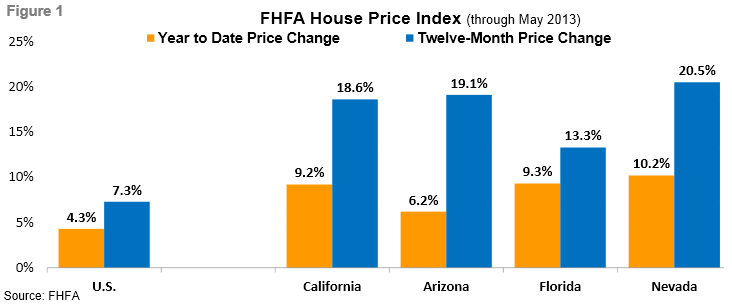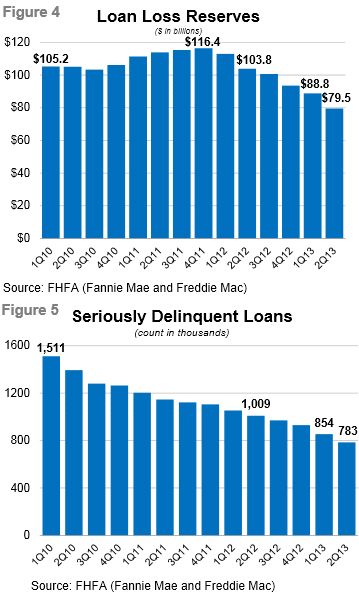On Thursday the Federal Housing Finance Agency (FHFA) released the first Quarterly Performance Report of the Housing GSEs. The report summarizes data on the two government sponsored enterprises (GSEs) Fannie Mae and Freddie Mac which are in conservatorship under FHFA and the Federal Home Loan Banks (FHLBanks) for which FHFA is the regulator.
Included in the report is information on the three entities finances, activities over the previous quarter, as well as data on what FHFA calls the "market drivers," home prices, mortgage interest rates, and swap rates.
FHFA says that both the GSEs and the FHLBanks reported positive earnings in the second quarter and this was significantly influenced by house prices which rose 4 percent for the year-to-date that ended in May, the seventh consecutive quarterly price increase. Earnings also benefited from increased hedging income driven by increases in interest rates in the second quarter.

The GSEs reported combined net income of $15.1 billion in the quarter and $78.4 billion in the first half of 2013. The latter number was in large measure due to Fannie Mae's release of a substantial portion of its valuation allowance against deferred tax assets in Q1, resulting in the recognition of a $50.6 billion tax benefit.
The GSE's portfolio quality continued to improve and the delinquencies of its legacy pre-2009 loans to decline. Rising prices lowered expected defaults on mortgages in most localities and reduced the severity of credit losses on sales of owned real estate (REO). These factors resulted in a $9.3 billion decrease in the GSEs combined loan loss reserves in the second quarter, resulting in a benefit of $6.0 billion; the third quarterly benefit in a row. There was an aggregate gain of $2.6 billion in the second quarter and $3.5 billion for the year-to-date accruing to the GSEs from fair value gains on derivatives used to hedge interest rate risk.
Seriously delinquent loans have also declined by 8 percent to approximately 783,000. This is down 22 percent from a year earlier.

Refinancing continued to drive new business volume, accounting for 79 percent of Fannie Mae's business and 81 percent of Freddie Mac's in the first half of the year. Refinancing through the Home Affordable Refinance Program (HARP) remained high following enhancements made to the program in late 2011.
The GSEs and Ginnie Mae continue to account for essentially all issuances of mortgage-backed securities (MBS). In the first half of the year the GSEs accounted for $728 billion or 77 percent of MBA issuances.
The FLHBank System generated $699 million, an increase of 22 percent from the first quarter. Year-over-year the System earned $134 million or 25 percent more than in the second quarter of 2012. "Focusing on the year-over-year figure, the higher net income was attributable to items in non-interest income - unrealized gains in derivatives and hedging activities, changes in fair value, and low credit impairment charges."
Holdings of private-label MBS continue to fall and are now 3 percent of assets. While the Banks have recorded cumulative credit impairment charges of $4.0 billion on these MBS, charges in the second quarter were less than $1 million.
Net interest income fell to 19 percent year-over-year because of reductions in yields on earning assets in the prolonged low rate environment and declines in asset balances. Return on assets of 37 basis points was 6 basis points higher than in the first quarter and 7 higher than a year earlier.
As of the end of the quarter the Banks had combined assets of $775.2 billion, $36.3 billion more than the first quarter and $15.5 billion above the assets in the second quarter of 2012. The quarterly increase was primarily caused by a $40.2 billion increase in advances which represented 59.1 percent of assets at quarter-end compared to 56.6 percent on March 31, 2013. Investments decreased to 34.5 percent of assets from 36.5 percent in the previous quarter and mortgages declined to 6.0 percent from 6.5 percent.
Advances plus acquired member assets (AMA) average 65.4 percent of total assets across the system, ranging from 35.9 percent to 75.6 percent at each of the individual FHLBanks. These are two asset classes directly related to the mission of the System.

At the end of the quarter the System held $51.0 billion of regulatory capital and $43.1 billion of GAAP capital. The current System regulatory capital ratio is 6.6 percent and the current GAAP capital ratio is 5.6 percent. Both ratios marginally decreased over the quarter. Retained earnings now equal 1.5 percent of assets, the highest level in more than 20 years.







